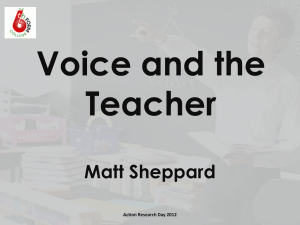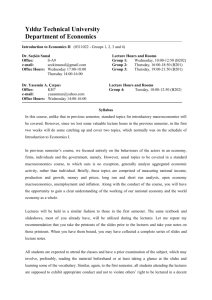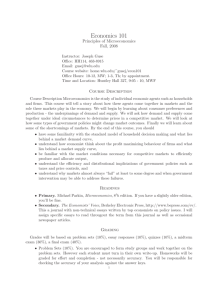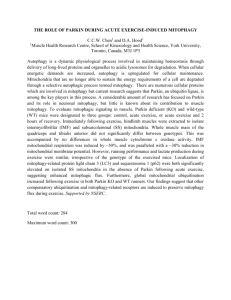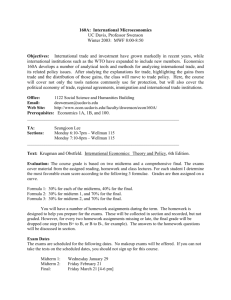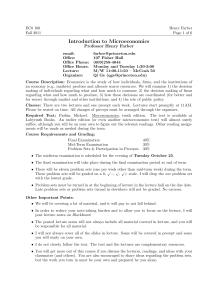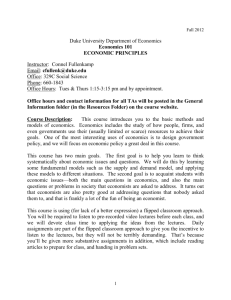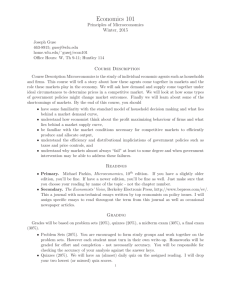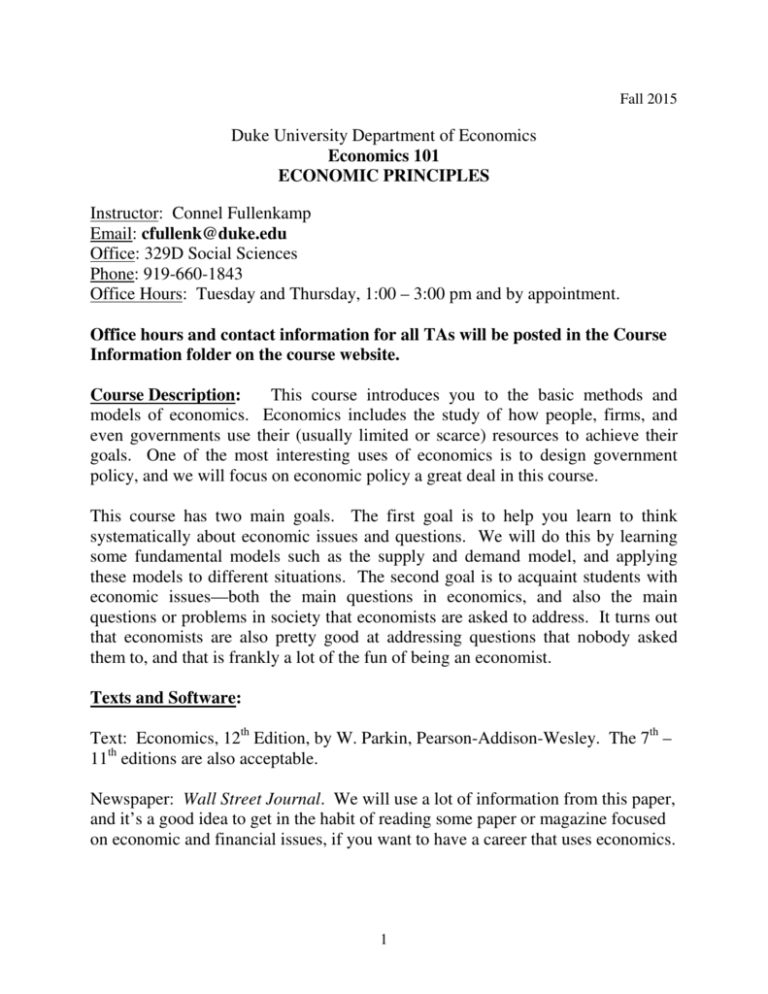
Fall 2015
Duke University Department of Economics
Economics 101
ECONOMIC PRINCIPLES
Instructor: Connel Fullenkamp
Email: cfullenk@duke.edu
Office: 329D Social Sciences
Phone: 919-660-1843
Office Hours: Tuesday and Thursday, 1:00 – 3:00 pm and by appointment.
Office hours and contact information for all TAs will be posted in the Course
Information folder on the course website.
Course Description:
This course introduces you to the basic methods and
models of economics. Economics includes the study of how people, firms, and
even governments use their (usually limited or scarce) resources to achieve their
goals. One of the most interesting uses of economics is to design government
policy, and we will focus on economic policy a great deal in this course.
This course has two main goals. The first goal is to help you learn to think
systematically about economic issues and questions. We will do this by learning
some fundamental models such as the supply and demand model, and applying
these models to different situations. The second goal is to acquaint students with
economic issues—both the main questions in economics, and also the main
questions or problems in society that economists are asked to address. It turns out
that economists are also pretty good at addressing questions that nobody asked
them to, and that is frankly a lot of the fun of being an economist.
Texts and Software:
Text: Economics, 12th Edition, by W. Parkin, Pearson-Addison-Wesley. The 7th –
11th editions are also acceptable.
Newspaper: Wall Street Journal. We will use a lot of information from this paper,
and it’s a good idea to get in the habit of reading some paper or magazine focused
on economic and financial issues, if you want to have a career that uses economics.
1
Software: A spreadsheet such as Excel is a very useful piece of software to use to
think about economics and business. You should start to learn how to use a
spreadsheet, and some of the problem sets in the course will help you do this by
requiring you to use a spreadsheet.
We will also use Sakai to deliver most course materials: https://sakai.duke.edu.
Please look in the Resources folder first—most things will be there.
Requirements:
This course will meet 3 times per week, MWF 11:45 – 1:00 pm (Section 1) or
1:25 – 2:45 pm (Section 2).
There will not be official discussion sections, though there will be weekly sections
that will cover specific problems on problem sets. Attendance to these is
voluntary. The TAs will hold office hours each week, with the purpose of
answering your questions about the lectures and giving help on the problem sets.
The graded work in the course will consist of problem set assignments and
timed, in-class exams.
Problem Sets: The purpose of the problem sets is to give you some practice with
the concepts and models that we will be covering in the course. Doing the problem
sets will be your best preparation for the exams. To encourage you to do the
problem sets, they will be collected and scored, but only for completeness. It will
be your responsibility to compare your problem set answers to the answers posted
on the course website. (Hint: make a copy of your answers before you turn them
in so that you can compare your answers right away.)
Problem sets will generally (but not always) be due on Mondays, at the start of
class. If you miss the deadline to submit a problem set, you MAY NOT make it
up, under any circumstance.
You must STAPLE your problem sets together, and write your name LEGIBLY in
BLOCK CAPITALS in a prominent place on the first page. You will lose up to 2
points per problem set (out of 10) for not doing these things.
I encourage you to work in groups on your problem sets, but each student must
hand in their own copy of the problem set.
2
Problem sets will be worth 80 points total. This is just under 10% of your final
grade.
Exams: There will be 3 exams in this course. The exams are your chance to show
independently that you understand and can use the concepts and models studied in
this course. The first two exams are midterms and will be worth 200 points
each. The third exam will be a comprehensive final exam and will be worth
400 points.
Exam Schedule
The following dates are reserved for midterm exams: 21 September and 4
November.
The final exam will be on December 8, at 2 pm for the 11:45 section (001) and
on December 12, at 2 pm for the 1:25 section (002).
Late Work and Missed Exam Policy
Late problem sets will not be accepted. Missed problem sets may not be made up.
Because of the size of the class, no makeup midterm exams will be given. If you
miss a midterm and obtain a University excuse for having done so, you may shift
the weight of the missed midterm onto the other exams. If you miss more than
one midterm for any reason, you will have to have a special conference with me
and your academic dean to determine whether you should continue in the course.
And be advised: my position will be to have you withdraw from the course in such
a circumstance.
Statute of Limitations
If you miss a midterm, you have up to 48 hours after the midterm exam to contact
me in some way to let me know that you have or will be bringing me a University
excuse for the absence from the exam. If you do not meet this deadline, you will
automatically receive a 0 on the exam missed.
You have one week from the date the exam is officially handed back (midnight of
the seventh day following the day the exam was handed back) in which to petition
3
to have the grading on all or part of your midterm exam reconsidered. After that
deadline, no petitions for reconsideration will be accepted.
Petitions to reconsider scores on first two midterm exams
If you believe that your score on an exam was incorrect or that you should receive
more credit for your work, you must submit this petition in writing to the Head
Graduate TA for the course by the statute of limitations deadline. Please note that
there will be no re-grading for the final exam.
In your petition, you must describe specifically and carefully why you believe that
your answer deserves more credit than it has been awarded. If there has been a
simple addition mistake when your score was calculated, all you need to write on
your petition is “Mistake in adding up the total score.”
Append your petition to the original copy of your exam answers and submit it to
the Head TA. The Head TA will make a ruling on the petition and notify both you
and me of the status of the petition. I will accept appeal petitions only—you must
petition the Head TA first, and after your petition has been reviewed by the Head
TA and returned to you, you have the option to appeal to me. You must write an
additional appeal petition, appended to the exam plus original petition, that
explains exactly why you believe that the Head TA’s ruling was not appropriate.
You have 48 hours after you have been notified (by email) that the petition is ready
to be picked up in order to submit your appeal.
Please note: The entire exam may be regraded if it is submitted for
reconsideration, even on appeal.
Note on Course Meetings:
This course is scheduled to meet three times per week for 75 minutes, rather than
50 minutes. This is to accommodate a commitment I have that requires me to be
out of town during part of the semester. Because the course meets three times per
week for 75 minutes, we will significantly exceed the minimum required contact
hours for a full-credit Duke course.
4
Duke University's Academic Honor Code
I remind you of the Duke Community Standard:
I. The Duke Community Standard
Duke University is a community of scholars and learners, committed to the principles of honesty, trustworthiness,
fairness, and respect for others. Students share with faculty and staff the responsibility for promoting a climate of
integrity. As citizens of this community, students are expected to adhere to these fundamental values at all times,
in both their academic and non-academic endeavors.
The Pledge
Students affirm their commitment to uphold the values of the Duke University community by signing a pledge that
states:
1. I will not lie, cheat, or steal in my academic endeavors.
2. I will conduct myself responsibly and honorably in all my activities as a Duke student.
3. I will act if the Standard is compromised.
The Reaffirmation
Upon completion of each academic assignment, students will be expected to reaffirm the above commitment by
signing this statement: “I have adhered to the Duke Community Standard in completing this assignment.” [Student
Signature]
II. Definitions
Lying is the expression of a material untruth made with the intent to mislead another or with reckless disregard for
the truth of the matter asserted. The material untruth may be uttered or presented, verbally, electronically, or in
writing, to another member of the University community (student, faculty or staff). An untruth is material when it
relates to or affects in a significant way activities of legitimate concern to the University community.
Cheating is the act of wrongfully using or attempting to use unauthorized materials, information, study aids, or the
ideas or work of another in order to gain an unfair advantage. It includes, but is not limited to:
•
•
•
•
•
•
plagiarism;
giving unauthorized aid to another student or receiving unauthorized aid from another person on tests,
quizzes, assignments or examinations;
using or consulting unauthorized materials or using unauthorized equipment or devices on tests, quizzes,
assignments or examinations;
using any material portion of a paper or project to fulfill the requirements of more than one course unless
the student has received prior permission to do so;
intentionally commencing work or failing to terminate work on any examination, test, quiz or assignment
according to the time constraints imposed; or
failing to adhere to an instructor’s specific directions with respect to the terms of academic integrity or
academic honesty.
“Plagiarism” occurs when a student, with intent to deceive or with reckless disregard for proper scholarly
procedures, presents any information, ideas or phrasing of another as if they were his or her own and
does not give appropriate credit to the original source. Proper scholarly procedures require that all quoted
material be identified by quotation marks or indentation on the page, and the source of information and
ideas, if from another, must be identified and be attributed to that source. Students are responsible for
learning proper scholarly procedure.
The term "assignment" includes any work, required or volunteered, and submitted to a faculty member for
review and/or academic credit.
All academic work undertaken by a student must be completed independently unless the faculty member
or other responsible authority expressly authorizes collaboration with another.
5
Stealing is the intentional taking or appropriating of the academic work product of another without consent or
permission and with the intent to keep or use the academic work product without the owner's or the rightful
possessor's permission.
Responsible and Honorable Conduct means adhering to state and federal laws, residential and academic
regulations, and the policies of Duke University as explicated in the Bulletin of Information and Regulations of Duke
University.
III. Students’ Obligation to Report Potential Cases of Academic Dishonesty. Under the Duke Community
Standard, students affirm their commitment not to lie, cheat, or steal in academic endeavors, nor accept the
actions of those who do.
The university recognizes that it is not always easy to act in these situations, but several alternatives are available
to suit a student’s level of comfort and confidence. These alternatives are not mutually exclusive.
•
Speaking directly with the individual exhibiting the behavior, both to gain clarity about the situation and to
inform the individual about the concern.
•
•
Publicly calling attention to the behavior as it is occurring.
•
For cases involving academic integrity, alerting the instructor that cheating may be occurring in the course.
This alert can be in any form, including anonymous notification, and the reporting student will not be identified.
The information provided will allow the faculty member to consider corrective measures, in consultation with
the Associate Dean for Judicial Affairs, and to address the topic with the class or suspected student(s).
Directly alerting the Associate Dean for Student Conduct within the Dean of Students Office (919-684-6938,
conduct@duke.edu), who will confer with the faculty member involved, if an academic issue, or with the
reporting student(s), strategizing next steps. Maintaining the confidentiality of the source is possible, but may
limit the extent of action that can be taken.
To this standard, I add the following comments:
• Any kind of conduct that shows lack of academic integrity, or lack of
respect for others’ rights to learn and be graded fairly, is a Code
violation.
• Any attempt to gain an unfair advantage over fellow students on any
graded exercise is a Code violation. If you are unsure about the use of any
form of aid, ask me about it before you use it.
• The most serious type of academic dishonesty is handing in someone
else's work and claiming that it is your own. This includes collaborating,
even with a student who is not in this course or section, on any graded work
that is supposed to be done independently. Please note that I permit and
encourage you to work in groups on your problem sets. All exams are to be
done independently. If I do not specify, you are to assume that you must
work independently.
I believe that you are honest. Nevertheless, if I see evidence of any breach
of academic integrity, I will confront it according to the procedures described in
the Bulletin of Duke University.
6
Broad Outline of the Course
We begin by learning to use the Production Possibilities Frontier model, which is a
model that can be used to understand many different choices that individuals,
businesses, and even entire societies (and their policymakers) make.
Then we move on to microeconomics, which is the study of individual markets.
We’ll spend a lot of time on how businesses make their production and supply
decisions, which is also called the Theory of the Firm. Because of time limitations,
we’ll give a much briefer treatment to consumer choice theory.
Then we’ll put the two sides of the market together and use the Supply and
Demand model in both the short run and the long run. We’ll spend a lot of time
applying this model to different industries and situations, including many types of
government interventions in markets.
After the first midterm exam, we’ll turn to macroeconomics, which is the analysis
of the aggregated markets that make up the overall economy. We’ll spend some
time on measurement issues first, since these turn out to be quite important.
We’ll develop the Aggregate Supply-Aggregate Demand model, which will be our
main tool of macro analysis, and spend a lot of time understanding how to use this
model to think about economic policy in the overall economy. We’ll learn about
many of the big controversies in macroeconomics regarding the best policies to
choose to keep the economy stable and growing. Because of timing issues, we will
study monetary policy and inflation after the second midterm.
In the final part of the course, we’ll add an international dimension to both the
macro and micro models that we’ve studied. We’ll start by learning about the
Balance of Payments and analyze how trade in goods, services and assets affects
the overall economy. We’ll pay special attention to the market for foreign
currency and analyze how exchange rates interact with the economy and economic
policy.
Finally, we’ll end by studying international trade in specific goods and services.
This is a good way to review many of the microeconomic ideas that we covered in
the first part of the semester.
A more specific guide to the topics covered follows below.
7
Schedule of Topics Covered and Assignment Due Dates
Date
24-Aug
26-Aug
28-Aug
Day
of
Week
M
Topics Covered
Assignment
*Course Logistics
*Introduction to Economics
*The Tools of Economics
Parkin, Chapter 1
Ch. 1 Appendix on
Graphing
*The Production Possibilities
Frontier (PPF) Model
Parkin, Chapter 2
W
F
*More Applications of the PPF
Model
31-Aug
M
*Introduction to Microeconomics
*What Businesses Do
*Efficiency, Production, and
Profits
2-Sep
W
*Cost Functions and the Supply
Curve
*What Affects the Supply of a
Product?
4-Sep
Problem Set 1 Due
Parkin, Chapter 10
Parkin, Chapter 11
Parkin, Chapter 12 through
"The Firm's Output
Decision"
F
*The Demand Side of the Market Parkin, Chapters 8 and 9
*Calculating and Using Elasticity Parkin, Chapter 4
7-Sep
M
*The Supply and Demand Model
in the Short Run
*Applying the Supply and
Demand Model
9-Sep
W
*A Supply and Demand Model of
Banking
8
Problem Set 2 Due
Parkin, Chapter 12 "Output
Price and Profit in the
Short Run"
Parkin, Chapter 3
11-Sep
F
*Government Interventions in
Markets
*The Social Impact of
Government Intervention
14-Sep
M
Parkin, Chapters 5 and 6
Problem Set 3 Due
*How Taxes Affect Markets
*Market Supply in the Long Run
16-Sep
W
*Long Run Competitive
Equilibrium
18-Sep
Parkin, Chapter 12
(Remainder of Chapter)
F
Review for Exam 1
21-Sep
M
Exam 1
23-Sep
W
*Growth Rate Math
*Introduction to the
Macroeconomy
Parkin, Chapters 21-22
Parkin, Chapter 23 through
“Long Term Growth
Trends”
*Introduction to the Aggregate
Goods Market
25-Sep
F
*Introduction to the Aggregate
Labor Market
*Introduction to the Aggregate
Financial Market
Parkin, Chapter 18
Parkin, Chapter 23, “Why
Labor Productivity Grows”
Parkin, Chapter 24,
"Financial Institutions and
Markets"
*Introduction to the Aggregate
Supply-Aggregate Demand
Model
28-Sep
M
*Aggregate Supply and Demand
Curves
*Equilibrium in the Aggregate
Supply-Aggregate Demand
Model
9
Parkin, Chapter 27
Parkin, Chapter 23, “How
Potential GDP Grows”
30-Sep
W
Problem Set 4 Due
October 5
*Applying the Aggregate SupplyAggregate Demand Model
26-Oct
28-Oct
30-Oct
M
*The Multiplier Effect
Parkin, Chapter 28
*Fiscal Policy
Parkin, Chapter 30
Parkin, Chaper 24
W
F
2-Nov
M
*Arguments Against Fiscal
Policy Effectiveness
*Supply Side Economics
Review for Exam 2
4-Nov
W
Exam 2
6-Nov
F
*Introduction to Money and
Monetary Policy
Parkin, Chapter 25
9-Nov
M
*A Bank-Based Model of
Monetary Policy
*How Monetary Policy Affects
the Economy
Parkin, Chapter 31
*Causes of Inflation
*The Phillips Curve and
Monetary Policy
Parkin, Chapter 25
Parkin, Chapter 29
*Introduction to International
Economics
*International Macroeconomics
Parkin, Chapter 26
11-Nov
13-Nov
16-Nov
W
F
M
Problem Set 6 Due
*Exchange Rates and Markets for
Foreign Currency
18-Nov
Problem Set 5 Due
W
*Exchange Rates and the
Macroeconomy
*Exchange Rate Policies
10
20-Nov
F
*Currency Unions and Their
Consequences
23-Nov
30-Nov
M
*Comparative Advantage and
Trade
Problem Set 7 Due
Parkin, Chapter 2 "Gains
From Trade"
*Tariffs and Quotas
Parkin, Chapter 7
Review for Final Exam
Problem Set 8 Due
M
2-Dec
W
4-Dec
F
11

